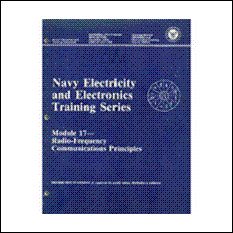Radiation Resistance
Radiated energy is the useful part of the transmitter's signal. However, it represents as much of a loss to the antenna as the energy lost in heating the antenna wire. In either case, the dissipated power is equal to I2R. In the case of heat losses, the R is real resistance.
In the case of radiation, R is an assumed resistance; if this resistance were actually present, it would dissipate the same amount of power that the antenna takes to radiate the energy. This assumed resistance is referred to as the RADIATION RESISTANCE.
Radiation resistance varies at different points on the antenna. This resistance is always measured at a current loop. For the antenna in free space, that is, entirely removed from any objects that might affect its operation, the radiation resistance is 73 ohms. A practical antenna located over a ground plane may have any value of radiation-resistance from 0 to approximately 100 ohms. The exact value of radiation resistance depends on the height of the antenna above the ground.
For most half-wave wire antennas, the radiation resistance is about 65 ohms. It will usually vary between 55 and 600 ohms for antennas constructed of rod or tubing. The actual value of radiation resistance, so long as it is 50 ohms or more, has little effect on the radiation efficiency of the antenna. This is because the ohmic resistance is about 1 ohm for conductors of large diameter. The ohmic resistance does not become important until the radiation resistance drops to a value less than 10 ohms. This may be the case when several antennas are coupled together.
RADIATION TYPES AND PATTERNS
The energy radiated from an antenna forms a
field having a definite RADIATION PATTERN. A radiation pattern is a plot
of the radiated energy from an antenna. This energy is measured at
various angles at a constant distance from the antenna. The shape of
this pattern depends on the type of antenna used. In this section, we
will introduce the basic types of radiation (isotropic and anisotropic)
and their radiation patterns.
Isotropic Radiation
Some antenna sources radiate energy equally in all directions. Radiation of this type is known as ISOTROPIC RADIATION. We all know the Sun radiates energy in all directions. The energy radiated from the Sun measured at any fixed distance and from any angle will be approximately the same. Assume that a measuring device is moved around the Sun and stopped at the points indicated in the figure below to make a measurement of the amount of radiation. At any point around the circle, the distance from the measuring device to the Sun is the same. The measured radiation will also be the same. The Sun is therefore considered an isotropic radiator.

Isotropic radiator.
To plot this pattern, we will assume that the radiation is measured on a scale of 0 to 10 units and that the measured amount of radiation is 7 units at all points. We will then plot our measurements on two different types of graphs, rectangular- and polar-coordinate graphs. The RECTANGULAR- COORDINATE GRAPH of the measured radiation, shown in view A of the figure below, is a straight line plotted against positions along the circle. View B shows the POLAR-COORDINATE GRAPH for the same isotropic source.

Comparison of rectangular- and polar-coordinate graphs for an isotropic source.
In the rectangular-coordinate graph, points are located by projection from a pair of stationary, perpendicular axes. In the polar-coordinate graph, points are located by projection along a rotating axis (radius) to an intersection with one of several concentric, equally-spaced circles. The horizontal axis on the rectangular-coordinate graph corresponds to the circles on the polar-coordinate graph. The vertical axis on the rectangular-coordinate graph corresponds to the rotating axis (radius) on the polar-coordinate graph.

















